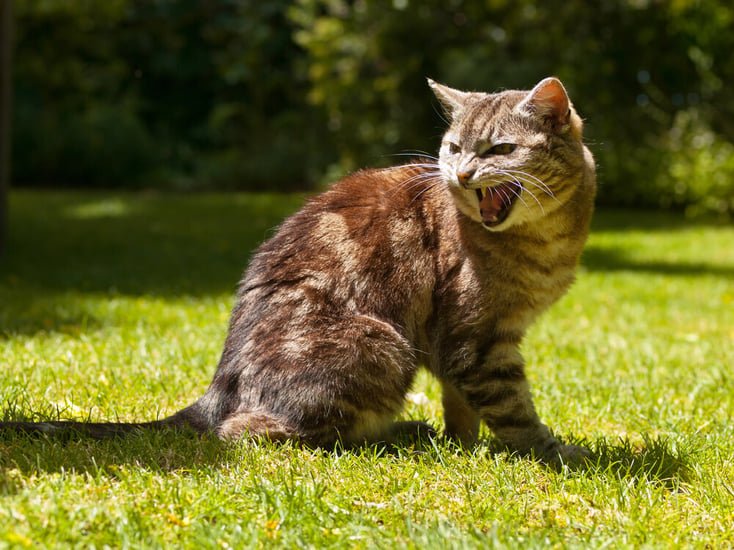Table of Contents
Aggression in cats can be a challenging issue for pet owners, leading to a stressful environment for both the cat and its human family. Understanding and addressing aggression in cats is essential for ensuring a peaceful home. In this article, we provide 10 effective strategies to help manage and reduce aggressive behavior in your feline friend.

Understand the Causes of Aggression in Cats
Before you can effectively address aggression, it’s important to understand the underlying causes. Common reasons for aggression in cats include fear, territorial behavior, pain, and redirected aggression. For more on understanding these causes, visit ASPCA Cat Behavior Issues.
Identify the Type of Aggression in Cats
Identifying the type of aggression your cat is exhibiting can help you address it more effectively. Types of aggression in cats include play aggression, fear aggression, territorial aggression, and redirected aggression. For more on identifying aggression types, see Humane Society Aggression Types.
Create a Safe and Calm Environment for Your Cat
Providing a safe and calm environment can help reduce your cat’s stress and aggression. Ensure your home has plenty of hiding spots, vertical spaces, and quiet areas where your cat can retreat. For tips on creating a cat-friendly environment, visit The Spruce Pets Environment Enrichment.
Use Positive Reinforcement to Address Aggression in Cats
Rewarding your cat for calm and non-aggressive behavior with treats, praise, and affection can help reinforce good behavior. Avoid punishment, as it can increase fear and aggression in cats. For more on positive reinforcement, see Humane Society Positive Training.
Provide Mental and Physical Stimulation for Cats
Ensuring your cat has plenty of opportunities for mental and physical stimulation can help reduce aggression. Provide interactive toys, puzzle feeders, and regular play sessions. For more on cat enrichment, visit ASPCA Cat Enrichment.
Manage Inter-Cat Aggression
If you have multiple cats, inter-cat aggression can be a common issue. Ensure each cat has their own resources, such as food bowls, litter boxes, and sleeping areas. Gradual introductions and supervised interactions can help reduce tension and aggression in cats. For more on managing inter-cat aggression, see Cornell Vet Inter-Cat Aggression.
Address Medical Issues in Aggressive Cats
Sometimes, aggression in cats can be a sign of underlying medical issues. If your cat’s behavior changes suddenly or seems out of character, consult your veterinarian to rule out any health problems. For more on health-related aggression, visit PetMD Cat Aggression.
Use Pheromone Products to Reduce Aggression in Cats
Pheromone diffusers and sprays can help create a calming environment for your cat. These products mimic natural calming pheromones and can be effective in reducing stress and aggression in cats. For more on pheromone products, see The Spruce Pets Cat Pheromones.
Gradual Exposure to Aggression Triggers in Cats
If your cat’s aggression is triggered by specific situations or stimuli, gradual exposure can help desensitize them. Start with low-intensity exposure and gradually increase it, rewarding calm behavior. For more on desensitization techniques, visit ASPCA Fear in Cats.
Consult a Professional for Aggressive Cats
If your cat’s aggression persists despite your efforts, consider consulting a professional animal behaviorist. They can provide personalized strategies and support to address your cat’s specific needs. For more on finding a behaviorist, see APDT Find a Trainer.
Conclusion
Addressing aggression in cats requires understanding the underlying causes and implementing effective strategies to manage and reduce aggressive behavior. By creating a safe environment, using positive reinforcement, providing mental and physical stimulation, and seeking professional help if needed, you can help ensure a peaceful home for both you and your feline friend. For more tips on cat behavior and care, check out our Cat Care Guide.
FAQs on Addressing Aggression in Cats
What are common causes of aggression in cats?
Common causes include fear, territorial behavior, pain, and redirected aggression. Identifying the cause is crucial for effective management.
How can I safely introduce new cats to each other?
Gradual introductions, separate resources, and supervised interactions can help reduce tension and prevent aggression in cats.
Are there products that can help calm an aggressive cat?
Yes, pheromone diffusers and sprays can help create a calming environment and reduce stress-related aggression in cats.
What should I do if my cat suddenly becomes aggressive?
Consult your veterinarian to rule out any underlying medical issues that might be causing the behavior change.
How can I use positive reinforcement to reduce aggression in cats?
Reward your cat for calm and non-aggressive behavior with treats, praise, and affection to reinforce good behavior.
When should I seek professional help for my cat’s aggression?
If your cat’s aggression persists despite your efforts, consider consulting a professional animal behaviorist for personalized strategies and support.











